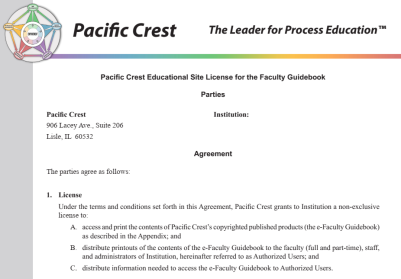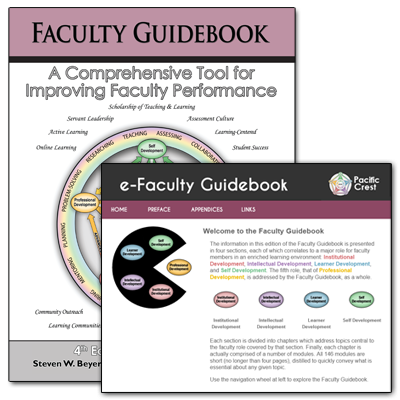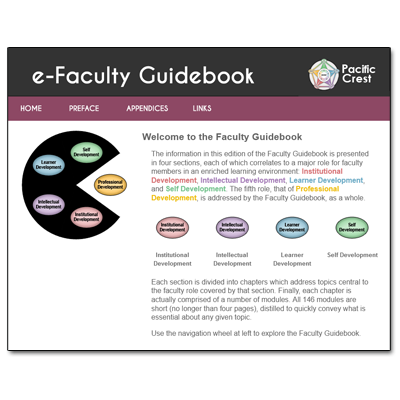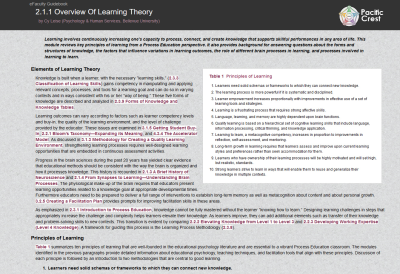Though it is an excellent background resource for a variety of topics, the Faculty Guidebook is truly application-oriented, providing you with tools to help you and your learning community integrate new and improved methods into your current practices.
A GOOD COMBINATION OF THEORY AND PRACTICE...
“This volume offers the promise of directly engaging faculty through an approach that integrates theory and practice, process and results, professional development and authentic practice, individual classrooms and systems. This is an invaluable aid in developing empowered learning communities as faculty teams continue their work focused on assessment.”
Hank Lindborg, Educational Consultant, AQIP
24/7 WEB ACCESS MADE POSSIBLE FOR ALL FACULTY...
“At Baker College, we have published the Faculty Guidebook on our web site for faculty to access whenever they need it. This allows 24/7 access from any location, which is important for our adjunct faculty; it allows them to use this resource for professional development in a way that suits their needs and schedules.”
Cindy VanGieson, Dean of Developmental Education, Baker College of Jackson
For most educators within higher education, the discipline of teaching and learning is a second discipline that is best served by resources that integrate educational theory with classroom practice. This is the design philosophy behind the Faculty Guidebook.
Overview and Basic Information
Education is a journey of discovery for both the learner and the teacher. There can be a lot of twists and turns along the way. And sometimes it's not too clear if you're even headed in the right direction.
More than 45 different authors stand ready to assist you by sharing their research on the very best practices to improve both teaching and learning in the fourth edition of the Faculty Guidebook. This invaluable resource will keep you on abreast of the latest research and scholarly thinking on such topics as mentoring, assessment and evaluation, instructional design, program assessment, and creating quality learning environments. These topics are packaged in short, comprehensive two to four page modules, making it easy to quickly absorb, research, apply, and disseminate new teaching/learning knowledge and classroom innovations.
The Faculty Guidebook will enhance your understanding of the various contexts of education and development: professional, learner, intellectual, institutional, and self development, serving as an authoritative resource that fosters transformation in these five areas.
The fourth edition of the Faculty Guidebook contains one hundred forty-six modules, blending theory and practice in an easy-to-use format. But as valuable as these modules are, the true value of the Faculty Guidebook goes far beyond what is contained between its covers. We are justifiably proud of the scholarship it contains, but also excited by the promise of the Faculty Guidebook. As you use this handbook to help with your professional development, your growth will have a powerful impact on your colleagues, your students, and those you mentor. Imagine this kind of transformation on an institutional scale: this is the promise of the Faculty Guidebook.
Single copy, personal, or site license purchases make it easy to start on the path to professional development.
Organization
The information in this edition of the Faculty Guidebook is presented in four sections, each of which correlates to a major role for faculty members in an enriched learning environment: Institutional Development, Knowledge Development, Learning Development, and Self-Growth. (See the front cover; the fifth role, that of Professional Development, is addressed by the Faculty Guidebook, as a whole.)
Each section is divided into chapters which address topics central to the faculty role covered by that section. Finally, each chapter is actually comprised of a number of modules. All 146 modules are short (no longer than four pages), distilled to quickly convey what is essential about any given topic. Most chapters begin with an overview module, so you can easily skim the contents of the entire book just by reading the chapter overviews. Each module provides you with references, allowing you to apply the material with confidence, knowing that methods have been tested and that successes are supported with evidence.
You can also access the original material if you want to find out more about the subject. In addition, each chapter contains an annotated bibliography that provides you with the chapter editor's “short list†of top reference picks to facilitate deeper study of a topic. To minimize overlap and needless repetition, frequent references within the modules point you to related entries elsewhere within the Faculty Guidebook. These references are bolded and italicized.
Aims, Goals, and Vision
This extensive multi-year project will package over 15 years of knowledge and experience related to improving faculty performance in higher education. The main outcome of the project, the Faculty Guidebook, will have the look, feel, and substance of refereed conference proceedings.
Our expectation is that the Faculty Guidebook will become a preferred, first-reference for those who want to expand their understanding and implementation of educational philosophy, learning theory, mentoring, teaching, assessment and evaluation, curriculum design, and institutional effectiveness.
The focus will be on innovations (intellectual property) related to advanced research and best practices that improve teaching/learning; presenting theoretical topics for which there are practical and effective applications in higher education.
Multiple Uses
The Faculty Guidebook is meant to be used in the following contexts:
a general purpose resource tool for all faculty desiring to improve their performance.
a reference used by higher education institutions to support their faculty development efforts.
a resource to help faculty mentor their junior colleagues.
a resource providing the basis for implementing a "graduate student training system."
a tool for moving classroom innovations to conferences and publications (rapidly converting new teaching/learning knowledge into a peer reviewed reference).
a resource tool during Pacific Crest workshop activities.
a resource to support "on-line" and distance learning environments.
a resource for smaller corporate trainers and training firms (vendor expos, local training organizations, professional societies such as ASTD).





